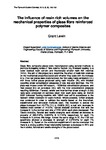The influence of resin rich volumes on the mechanical properties of glass fibre reinforced polymer composites
| dc.contributor.author | Lewin, G. | |
| dc.date.accessioned | 2019-05-20T10:25:50Z | |
| dc.date.available | 2019-05-20T10:25:50Z | |
| dc.date.issued | 2016 | |
| dc.identifier.citation |
Lewin, G. (2016) 'The influence of resin rich volumes on the mechanical properties of glass fibre reinforced polymer composites', The Plymouth Student Scientist, 9(2), p. 123-159. | en_US |
| dc.identifier.issn | 1754-2383 | |
| dc.identifier.uri | http://hdl.handle.net/10026.1/14131 | |
| dc.description.abstract |
Glass fibre composite plates were manufactured using several methods to promote increasing levels of fibre volume fraction (Vf), inversely leading to a lower residual resin content and theoretically smaller resin rich volumes (RRV). The aim of this project is to determine the effect of resin rich volumes on the mechanical properties tested and whether they scale with the increase in Vf. Five test plates were manufactured, the first using hand-lamination (HL) with three further plates produced using resin infusion (RI), with infusion occurring under consolidation pressures of 300, 600 and 900mbar. The fifth plate was infused under full vacuum, ~1000mbar consolidation pressure, and then placed into an autoclave (AC) with the total consolidation pressure reaching 5860mbar. Flexural, tensile and inter-laminar shear strength (ILSS) tests were conducted on samples taken from each plate using an Instron 5582 Universal Testing machine with 100kN load cell in accordance to the relevant British Standard for each method. Where possible, further analysis was conducted in order to validate the results based on the theoretical, experimental and simulated methods used. The recorded Vf across the plates increased from 40.77% (HL) to 49.60% (AC), a real term decrease in residual resin content of 14.91%. Optical analysis confirmed that with the increase in Vf the number and size of RRV within each plate decreased. The Elastic modulus, flexural and tensile strengths each showed an increase in property of 365.2MPa, 6.68MPa & 9.11MPa respectively for each 1% increase in Vf across this range. Across the same range in Vf, the ILSS test specimens showed a decrease in strength of 0.373MPa for each 1% increase in Vf. Based on the conducted experiments it can be concluded that there is a strong positive linear relationship between a decrease in RRV and the modulus, flexural and tensile strengths of the plates tested. | en_US |
| dc.language.iso | en | en_US |
| dc.publisher | University of Plymouth | |
| dc.rights | Attribution 3.0 United States | * |
| dc.rights.uri | http://creativecommons.org/licenses/by/3.0/us/ | * |
| dc.subject | fibre volume fraction | en_US |
| dc.subject | resin rich volumes | en_US |
| dc.subject | hand-lamination | en_US |
| dc.subject | Glass fibre | en_US |
| dc.subject | Glass fibre composite plates | en_US |
| dc.subject | flexural and tensile strengths | en_US |
| dc.title | The influence of resin rich volumes on the mechanical properties of glass fibre reinforced polymer composites | en_US |
| dc.type | Article | |
| plymouth.issue | 2 | |
| plymouth.volume | 9 | |
| plymouth.journal | The Plymouth Student Scientist |



